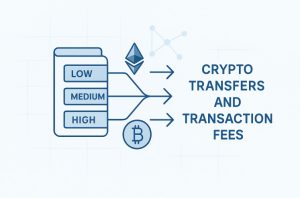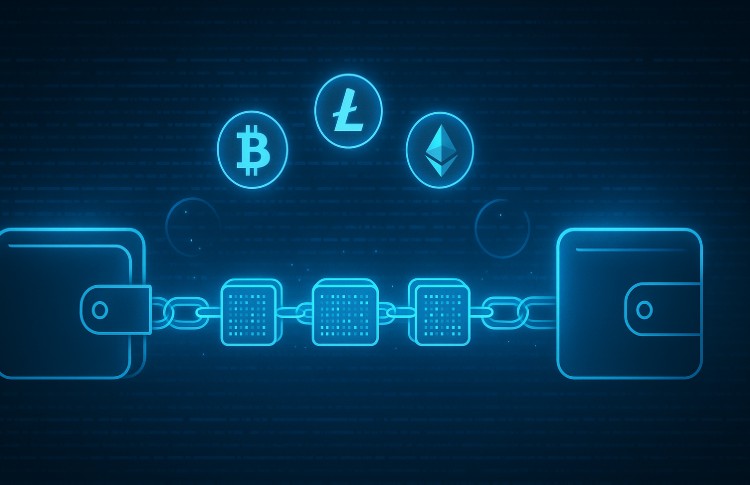The process of transferring cryptocurrency between wallets or accounts on a blockchain is most commonly known as a transaction. In its essence, a transaction refers to the movement of digital assets from one blockchain address to another.
It involves multiple steps—from the creation of a transfer request to the confirmation and recording of the transaction on a distributed ledger.
Understanding how these transactions work is essential not only for crypto enthusiasts but also for any individual or business engaging with digital currencies.
This article explores each stage of the cryptocurrency transfer process, helping readers grasp the fundamentals, avoid common mistakes, and make informed decisions.
What Is The Cryptocurrency Transfer Process On The Blockchain?

The process of transferring cryptocurrency between blockchain addresses is called a transaction. This term represents the complete movement of digital value from one user to another and includes both technical validation and final recording on a distributed ledger.
At the core of this process is the creation of a digital message, which includes the sender’s and recipient’s wallet addresses, the amount of cryptocurrency being transferred, and a digital signature created using the sender’s private key. The transaction also includes a timestamp to ensure chronological order on the ledger.
Once created, the transaction is shared across the blockchain network for verification. Nodes, which are individual computers on the blockchain, work together to validate the information, ensure there is no double-spending, and include the transaction in a new block. This block is added to the existing chain, completing the transfer and creating a permanent, transparent record.
How Do Wallet-To-Wallet Crypto Transfers Work?
Wallet-to-wallet cryptocurrency transfers are at the heart of blockchain utility, enabling the decentralised movement of digital assets without the need for intermediaries such as banks or payment processors. This process relies on cryptographic mechanisms and a peer-to-peer network to securely and transparently send funds from one user to another.
At its core, a wallet-to-wallet transfer involves the use of public and private keys, wallet addresses, and network confirmation. Every participant in the blockchain ecosystem has a wallet that can be software-based (hot wallet) or hardware-based (cold wallet), and each wallet is uniquely associated with a cryptographic key pair.
Key Concepts Behind Wallet Transfers
- Public Key: A cryptographic address that functions like a bank account number. It is safe to share and used by others to send funds to the wallet.
- Private Key: A secure code that acts like a password or signature. It must be kept secret and is used to authorise transactions from the wallet.
- Wallet Address: A hashed representation of the public key, typically shown as a string of letters and numbers or QR code, which uniquely identifies the destination for a transaction.
When someone initiates a wallet-to-wallet transfer, they input the recipient’s wallet address and the amount of cryptocurrency they wish to send. The sending wallet uses its private key to sign this transaction digitally, proving the sender has authorised the action.
This signed transaction contains three main pieces of information:
- Sender’s wallet address
- Recipient’s wallet address
- Amount of cryptocurrency being transferred
Optionally, some blockchains allow for metadata, such as messages or notes, to be attached.
Transaction Broadcast and Verification
Once the transaction is signed, it is broadcasted to the blockchain network. Broadcasting means that the transaction is submitted to the network of nodes (computers running the blockchain protocol) that validate transactions.
These nodes:
- Verify the sender has enough funds to complete the transaction
- Check that the digital signature is valid
- Ensure that the same cryptocurrency hasn’t been spent elsewhere (prevents double-spending)
Once verified, the transaction is placed into a mempool (a memory pool of pending transactions) where it waits to be included in a block. In Proof of Work blockchains like Bitcoin, miners pick up transactions and include them in new blocks. In Proof of Stake systems like Ethereum (post-Merge), validators perform this role.
Confirmation on the Blockchain

After being included in a block, the transaction receives a confirmation. Each new block added to the chain acts as an additional layer of confirmation, reducing the risk of reversal. For example, a Bitcoin transaction is typically considered final after six confirmations, while Ethereum may only require one or two.
Until the first confirmation is complete, the transaction is considered pending. Once confirmed, the crypto has officially been transferred and recorded on the blockchain ledger permanently.
Summary of Wallet-to-Wallet Transfer Flow:
| Step | Description |
| 1 | Sender enters recipient’s wallet address and amount |
| 2 | Transaction is digitally signed using sender’s private key |
| 3 | Signed transaction is broadcasted to the blockchain network |
| 4 | Nodes validate the transaction |
| 5 | Transaction is added to a block |
| 6 | Block is confirmed and recorded on the blockchain |
Wallet Compatibility and Network Matching
A key aspect of wallet-to-wallet transfers is ensuring network compatibility. Sending tokens on one blockchain (e.g., Ethereum) to an address on a different blockchain (e.g., Binance Smart Chain) without using a cross-chain bridge can result in lost funds.
For example:
- Sending ERC-20 tokens to a BEP-20 wallet address may not be recognised by the recipient wallet unless it supports both networks.
- Using a non-custodial wallet (where you hold the private key) provides more control, but requires more technical understanding than custodial wallets managed by exchanges.
Risks and Considerations
While the process is designed to be secure, several risks must be considered:
- Irreversible Transfers: Once confirmed, the transaction cannot be undone. Sending to the wrong address means the funds are permanently lost.
- Incorrect Network Use: Using the wrong network type when transferring to another wallet (e.g., sending via Ethereum when recipient expected Binance Smart Chain) may result in inaccessible funds.
- Phishing and Malware: Users must ensure their wallets are secure, avoid fake applications, and never share their private keys.
Understanding the technical workflow of wallet-to-wallet transfers allows users to operate safely within the decentralised ecosystem and take full advantage of blockchain’s trustless design.
What Are The Steps Involved In Sending And Receiving Cryptocurrency?
Sending and receiving cryptocurrency involves a structured, decentralised process that ensures secure and transparent transactions across a blockchain network.
Unlike traditional bank transfers, where a central institution validates and processes transactions, cryptocurrency transfers rely on distributed consensus and cryptographic verification.
Each transaction progresses through several technical and logical steps, from the moment a user initiates the transfer to its final confirmation and recording on the blockchain ledger.
Understanding these steps is crucial for both beginners and experienced users who want to ensure safe and efficient digital asset transfers.
Step 1: Initiating The Transaction
The process begins when a user opens their crypto wallet application and chooses the option to send funds. At this point, the following information is required:
- The recipient’s wallet address, typically a long alphanumeric string or QR code
- The amount of cryptocurrency to be sent
- The network or blockchain type, such as Ethereum, Bitcoin, or Solana
- The transaction fee (also called gas fee or network fee), which may be customisable depending on the platform
The user confirms the transaction details and authorises it using their private key. This action generates a digital signature, which proves ownership and permission to move the funds.
Step 2: Creating A Digitally Signed Transaction
Once the transaction is initiated, the wallet creates a structured transaction file that includes:
- Sender’s wallet address
- Recipient’s wallet address
- Amount to be transferred
- Timestamp
- Network fee
- Digital signature generated using the sender’s private key
This digital signature ensures the authenticity of the transaction. Anyone with access to the public key can verify that the transaction was indeed signed by the holder of the private key, without ever revealing the private key itself.
This cryptographic structure ensures that transactions cannot be forged or altered once they have been signed and sent to the network.
Step 3: Broadcasting The Transaction To The Network
After the transaction is signed, it is broadcasted to the blockchain network. Broadcasting refers to the process of sending the transaction data to all participating nodes in the blockchain system.
Each node receives the transaction and performs the following checks:
- Verifies that the digital signature is valid
- Confirms that the sender has sufficient balance
- Ensures that the transaction is not a duplicate or a double-spend attempt
Valid transactions are added to a temporary storage area called the mempool, which is a waiting area for transactions that are yet to be confirmed and included in a block.
Step 4: Validating The Transaction
Transactions in the mempool are selected by miners (in Proof of Work blockchains like Bitcoin) or validators (in Proof of Stake networks like Ethereum). These network participants are responsible for bundling valid transactions into a new block.
Validation includes:
- Verifying the transaction format and digital signature
- Ensuring the sender’s wallet has enough funds
- Checking against double-spend attacks
- Complying with the rules of the blockchain protocol
If the transaction passes all checks, it is added to a newly created block and queued for confirmation.
Step 5: Adding The Transaction To A Block
Once the transaction is validated, it becomes part of a block that is added to the blockchain. Each block contains a collection of recent transactions along with metadata such as the previous block hash, a timestamp, and the validator’s signature or proof of work.
The addition of the block to the chain serves two main purposes:
- It confirms the transaction, making it part of the official blockchain ledger
- It secures the transaction by linking it to previous blocks through cryptographic hashes
The more blocks that are added after a transaction’s block, the more secure and irreversible that transaction becomes. This process is referred to as block confirmation.
Step 6: Receiving The Cryptocurrency
From the recipient’s perspective, the transfer is complete once the transaction receives its first confirmation on the blockchain. However, most wallets and exchanges require multiple confirmations before they reflect the updated balance, especially for large transactions.
For instance:
- Bitcoin may require 6 confirmations
- Ethereum typically needs 12 or more for finality
- Solana and other newer blockchains often confirm within seconds
Once confirmed, the recipient’s wallet updates the balance, and the cryptocurrency becomes available for use or withdrawal.
Summary Table
| Step | Description |
| 1 | Initiate Transfer: Sender inputs recipient’s address, amount, and confirms with private key |
| 2 | Sign Transaction: Wallet generates a digital signature to authenticate the transaction |
| 3 | Broadcast: Transaction is submitted to the blockchain network |
| 4 | Validate: Nodes or validators confirm that the transaction is legitimate |
| 5 | Block Inclusion: The transaction is added to a new block and confirmed |
| 6 | Receive Funds: Recipient’s wallet reflects updated balance after confirmation |
Considerations During The Process
Several additional factors can affect the speed, cost, and success of cryptocurrency transfers:
- Network congestion: High transaction volumes can lead to delays and higher fees
- Gas price: Some blockchains allow users to set gas prices to influence transaction speed
- Wallet compatibility: Both sender and recipient must use wallets compatible with the same blockchain
- Transaction ID (TxID): After broadcast, users can monitor the status using the transaction hash on a blockchain explorer
Understanding the detailed workflow of sending and receiving cryptocurrency helps reduce errors and increases user confidence in navigating decentralised finance (DeFi) environments.
What Role Do Transaction Fees Play In The Crypto Transfer Process?

Transaction fees are essential in cryptocurrency transfers. These fees serve as an incentive for miners or validators who process and confirm the transactions on the blockchain. Without them, transactions might not be prioritised or included in blocks in a timely manner.
Fees can fluctuate based on:
- Network congestion
- Type of blockchain (e.g., Ethereum typically has higher fees than Solana)
- Desired transaction speed
A user may opt to pay a higher fee to receive faster confirmation times, particularly when the network is busy. Conversely, lower fees might delay transaction processing, especially during peak usage periods.
The fee is automatically deducted from the user’s wallet at the time of transaction initiation. This makes fee estimation and management an important part of using cryptocurrencies effectively.
How Secure Is Transferring Cryptocurrency Between Wallets?
Security in cryptocurrency transfers is one of the system’s key strengths, but it depends significantly on user practices. Blockchain technology provides a high level of security through encryption, decentralisation, and transparency.
Each transaction is encrypted and verified independently, and once added to the blockchain, it cannot be modified. This immutability ensures that all recorded transactions are permanent and publicly accessible.
Despite this strong foundation, human error or negligence can still compromise transfers. Mistyping a recipient address, using an untrustworthy wallet, or falling victim to phishing attacks are common risks.
Best practices for securing transfers:
- Use trusted wallet software
- Double-check recipient addresses before confirming
- Store private keys securely and offline when possible
- Avoid clicking unknown links or QR codes related to wallets
What Tools And Platforms Simplify The Cryptocurrency Transfer Process?

Numerous tools are available to streamline and secure cryptocurrency transfers. These tools help users send, receive, manage, and even track their crypto holdings effectively.
The type of wallet used plays a major role in usability and security. Platforms vary in features, fees, and the level of control provided to users.
Table: Comparison of Popular Crypto Wallet Platforms
| Platform | Type | Key Feature | Use Case |
| MetaMask | Hot Wallet (Browser) | Supports Ethereum and other networks | Suitable for DeFi transactions |
| Trust Wallet | Mobile Wallet | User-friendly, multi-chain support | Ideal for everyday usage |
| Ledger Nano X | Cold Wallet | Offline storage, high security | Best for long-term holdings |
| CoinTracker | Portfolio Manager | Tracks transfers and tax reporting | Useful for financial analysis |
| Coinbase Wallet | Exchange Wallet | Integrated with exchange platform | Great for beginners |
These tools allow users to control private keys, manage multiple assets, and integrate with decentralised applications. Some platforms also assist with transaction analytics and reporting, which is valuable for tax compliance and auditing.
What Are Common Mistakes To Avoid In Crypto Transfers?
Despite the efficiency of blockchain, mistakes during a transfer can result in irreversible losses. One of the major risks is sending cryptocurrency to the wrong wallet address. Since blockchain transactions are immutable, there is no way to retrieve funds once they are sent to an unintended destination.
Another common mistake is selecting the wrong network. For instance, sending Ethereum-based tokens (ERC-20) to a Binance Smart Chain address (BEP-20) can result in lost or locked assets.
Users should also pay attention to transaction fees. Choosing the lowest fee may result in failed or delayed transactions. Additionally, interacting with suspicious websites or fake wallet apps can compromise private keys.
Common mistakes include:
- Using incorrect recipient address or QR code
- Choosing the wrong blockchain network
- Not accounting for sufficient transaction fees
- Failing to confirm wallet compatibility
How Can Users Track And Verify Their Cryptocurrency Transactions?
Blockchain transparency allows users to track their transactions through public explorers. Every completed transaction receives a unique transaction hash or ID, which can be used to monitor its status.
This hash can be entered into a blockchain explorer specific to the cryptocurrency being used. The explorer displays relevant information such as:
- Number of confirmations
- Sender and receiver addresses
- Transaction amount
- Block number and timestamp
Table: Examples of Blockchain Explorers
| Blockchain | Explorer Website | Notable Feature |
| Bitcoin | blockchain.com/explorer | Simple interface for BTC |
| Ethereum | etherscan.io | Tracks tokens and smart contracts |
| Solana | solscan.io | Real-time block updates |
| Polygon | polygonscan.com | Cross-chain compatibility |
| Binance Smart Chain | bscscan.com | Popular with DeFi projects |
By using these tools, users can easily check whether their transfer has been successfully confirmed and diagnose issues if a transaction is pending.
How Is The Cryptocurrency Transfer Process Different Across Blockchain Networks?
While the overall process of transferring cryptocurrency is similar across networks, several factors vary significantly. These include the time it takes to confirm a transaction, the fee structure, and the consensus mechanism used.
Different blockchains employ different strategies to ensure the validity of transactions. For example, Bitcoin uses Proof of Work which involves energy-intensive mining, while Ethereum has transitioned to Proof of Stake which is more efficient. Solana uses Proof of History, optimising transaction speed.
Table: Comparison of Blockchain Transfer Characteristics
| Blockchain | Avg Confirmation Time | Avg Fee | Consensus Method |
| Bitcoin | 10 minutes | Medium | Proof of Work |
| Ethereum | 15 seconds | High | Proof of Stake |
| Solana | <5 seconds | Low | Proof of History |
| Polygon | 2 seconds | Low | Proof of Stake |
| Binance Smart Chain | 5 seconds | Low | Delegated Proof of Stake |
Understanding these differences can help users choose the right network for their specific transfer requirements, especially in terms of cost and speed.
Why Is Understanding The Crypto Transfer Process Important For Beginners?
For beginners in the cryptocurrency space, understanding how transfers work is fundamental to ensuring the security and success of their transactions. Lack of knowledge often leads to avoidable mistakes, such as sending funds to the wrong address or using the incorrect blockchain network.
By learning about key elements such as private key management, fee estimation, and confirmation tracking, users can gain confidence and reduce risks. A clear understanding of wallet types, transaction life cycle, and blockchain explorers equips them to participate more safely in the digital economy.
Some benefits of learning the process include:
- Avoiding irreversible errors
- Improving transaction speed and reliability
- Enhancing digital asset management
- Making informed decisions across different blockchain ecosystems
Conclusion
The act of moving cryptocurrency from one wallet to another is widely known as a transaction, but the cryptocurrency transfer process involves far more than just clicking “send”. From the use of cryptographic keys to validation by decentralised nodes and the final confirmation on the ledger, the process is a seamless yet powerful system powered by blockchain technology.
Understanding how it works not only empowers individuals but also fosters trust and responsibility in the decentralised economy.
FAQs about the Cryptocurrency Transfer Process
What is a crypto transaction hash and why is it important?
A transaction hash is a unique string of characters generated when a transaction is submitted to the blockchain. It serves as an identifier and allows users to track the status of their transaction on a blockchain explorer.
Can cryptocurrency transactions be reversed?
No, once a transaction is confirmed on the blockchain, it cannot be reversed. This immutability is a core feature of blockchain technology, highlighting the importance of address verification.
How long does a cryptocurrency transfer usually take?
Transfer times vary by blockchain. Bitcoin transactions may take 10 minutes, Ethereum takes around 15 seconds, while Solana can process transfers in under 5 seconds.
Do I need internet access to transfer cryptocurrency?
Yes, since transfers involve broadcasting data to a decentralised network, a stable internet connection is required to initiate and confirm transactions.
Are fees the same across all cryptocurrencies?
No. Transaction fees differ significantly between cryptocurrencies and networks. Ethereum often has higher gas fees compared to Solana or BSC due to network congestion.
What happens if I send crypto to the wrong wallet?
If sent to a valid but unintended wallet address, the transaction is irreversible. There is no central authority to recover funds, so double-checking addresses is vital.
Is it safe to store cryptocurrency in online wallets?
Online (hot) wallets offer convenience but are more vulnerable to hacks. Cold wallets, like hardware wallets, provide higher security by storing private keys offline.








